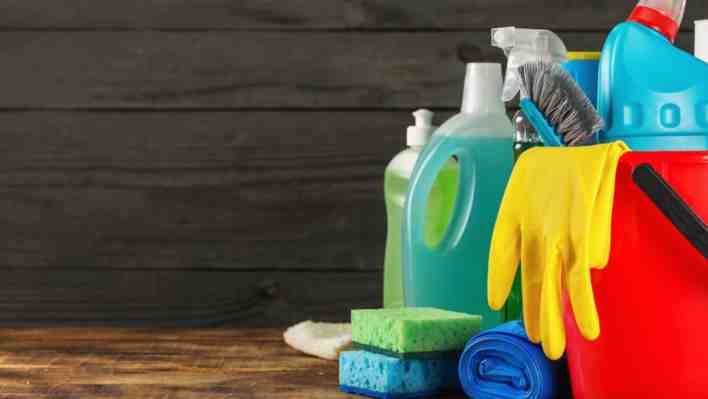Maintaining a regular cleaning and sanitizing schedule is integral to preventing cross-contamination and food-borne illness. There are four main types of cleaning agents used in commercial kitchens:

Detergents Degreasers Abrasives Acids
For effective cleaning, be sure to use the correct cleaning agent for the type of item to be cleaned, the cleaning method you’ll be using and the type of soiling on the item. Learn about the four most common types of cleaning agents and when to use them.
1. Detergents
Detergents are the most common type of cleaning agent and are used in home and commercial kitchens. They work by breaking up dirt or soil, making it easy to wash it away.
The detergents used in commercial kitchens are usually synthetic detergents made from petroleum products and may be in the form of powder, liquid, gel or crystals.
2. Degreasers
Degreasers are sometimes known as solvent cleaners and are used to remove grease from surfaces such as oven tops, counters and grill backsplashes.
Methylated spirits or white spirit were commonly used as degreasers in the past. Most food businesses now try to use non-toxic, non-fuming degreasers in their operations to prevent chemical contamination.
3. Abrasives
Abrasives are substances or chemicals that depend on rubbing or scrubbing action to clean dirt from hard surfaces. In commercial kitchens, abrasives are usually used to clean floors, pots and pans.
Abrasives should be used with care as they may scratch certain types of materials used for kitchen equipment such as plastic or stainless steel.
4. Acids
Acid cleaners are the most powerful type of cleaning agent and should be used with care. If they are not diluted correctly, acid cleaners can be very poisonous and corrosive.
Acid cleaners are generally used to remove mineral deposits and are useful for descaling dishwashers or removing rust from restroom facilities.
Properly handling cleaning agents
Remember that exposure to chemicals used in cleaning agents can lead to skin irritations, chemical poisoning, respiratory problems and, in extreme cases, even death. In a food business, all employees should be properly trained in understanding chemical hazards, how to handle products safely and what personal protective equipment should be worn when handling the product. Best practices for handling cleaning agents include:
storing chemicals in a secure place in their sealed original containers, well away from food or any equipment may come into contact with food
wearing personal protective equipment required to be worn when handling the product, such as gloves or safety glasses
following the manufacturer’s instructions when using the product or disposing of the product
cleaning and sanitising cleaning equipment such as brushes, mops and other janitorial tools after use and storing them in a well maintained, dry, locked area
using different cloths for wiping and cleaning, and replacing them regularly
Always follow cleaning with sanitizing
Cleaning is only the first step to a germ-free kitchen. Cleaning is done using detergent, but it doesn’t kill bacteria or other microorganisms that can cause food poisoning. To kill bacteria and ensure a clean workplace, you must follow cleaning with sanitizing.
Effective cleaning and sanitizing also helps to:
prevent pests from entering your business
prevent cross-contamination
prevent allergic reactions caused by cross-contamination
Make sure everyone who handles food in your business knows how to clean and sanitize properly and why it's important. Keep a regular kitchen equipment cleaning schedule to keep track of daily, weekly and monthly tasks.
Enrolling your staff in a food handling course can help to ensure that your business stays compliant with food safety laws and regulations, passes health inspections and protects customers from health risks like allergic reactions and food poisoning.
The Canadian Institute of Food Safety (CIFS) provides online food safety courses that are approved in every province and territory in Canada. For more information about our Food Handler Certification Course, contact us or view our food handling certificate course page.












